The Evolution of the Social Serigraphy Movement
In the San Francisco Bay Area, 1966-1986
[Note: This web essay was produced by Michael Rossman in 2007. Although he has passed away, his poster archive continues to be processed and developed by Lincoln Cushing.]
This account was written as the catalogue-essay for the exhibition "Speak! You Have the Tools!" at the de Saisset Museum of Santa Clara University in early 1987.
This presentation presently includes thumbnails of 18 of the 61 designs in the exhibition. Italic numbers in brackets refer to designs in the exhibition, listed below in an appendix. Bold-faced numbers in parentheses indicate designs reproduced in my "Poster Poster" from Mother Jones magazine (1993).
[A Social History]
The domestic political poster renaissance began in 1965-66 from several roots, as the emerging counterculture cross-fertilized the New Left, already seven years old, and the Farmworkers struggle developed. In the subsequent ferment, poster-making quickly became a prominent and universal activity among progressives -- amounting to a minor movement in itself, of social art, sprung from and serving a many-branched, evolving Movement for political and social justice. By 1986, this poster movement had produced over 100,000 designs nationally, a flood of images illuminating every activity of the complex social movement underlying it. This collective work is unique, in being the product of a populist movement without State support; and in the radical decentralization and diversity of its sources, influences, and directions.
The poster movement has flourished most vigorously in the San Francisco Bay Area, where more than 25,000 designs appeared during its first two decades. Silkscreened work accounted for one design in three, in part for technical reasons. Serigraphy enables anyone to produce vividly-colored, large posters in modest quantities, anywhere, quickly and relatively cheaply, with little equipment and training; yet it is suited also to the serious development of craft and art. These qualities matched the needs of a myriad of small organizations and artists involved in crisis politics and ongoing work -- particularly in low-income and working-class communities with little access to mass media -- and serigraphy became a major public medium. Silkscreened work records the most ephemeral, most local, most urgent activities of the underlying social movement, and includes many of its most powerful graphic expressions. In this sense, the medium displays the heart of the political poster renaissance.
Yet the practice of social serigraphy has developed not only for such technical reasons. Its evolution has had a social root and form, most fully developed in the Bay Area. This local history makes vivid many themes of the national renaissance, and accounts for the content, styles, and technical means of the serigraphy evolving here.
[A Broken Continuity]
During the 1950s, the main local focus of political art was the Graphic Arts Workshop in San Francisco. GAW's first generation carried on the Old Left's graphic tradition and imagery, making occasional posters for labor unions, peace causes, and Civil Rights. Though Frank Rowe, Irving Frohmer, and Richard Correll [53] produced serigraphs sporadically into the 1980s, by the time the New Left was well-begun their successors had reshaped GAW to emphasize craft rather than social committment, and it played no part in the renaissance that followed. Independent artists, like Lewis Suzuki [1], continued to do political silkscreens, but their work too was scattered and isolated, and without influence. When the poster movement finally developed, it arose spontaneously in a new generation. Among GAW's original artists, Rowe alone was able to play a small, vital role in it [26], when he returned to teaching after two decades on the political blacklist. His example provides the only significant link between the Old Left's artists and the new poster movement, and testifies to the repressive forces that disrupted the continuity of political culture.
[The New Movement Begins]
The poster movement's local origin is dated precisely. The Berkeley Free Speech Movement of late 1964 lasted three months and involved 10,000 students, but produced not a single poster image. The first design of the new era appeared in May 1965, to announce the Berkeley teach-in that generated the first mass organization of the emerging anti-war movement. Like the "psychedelic" rock-dance posters, which first appeared that summer, the Vietnam Day Committee's few posters were all printed by offset lithography. But as poster-making spread throughout the broader Movement, scattered silkscreens began to appear.
The earliest designs were announcements, done by isolated artists for groups on the Movement's expanding, mutating frontier. A Civil Rights support group hosts the leader of the emerging Chicano movement [2]; a medic corps, formed under police attack in the streets, reorganizes itself as a community clinic [3(4)]. Such pieces were rudimentary in technique, using the simplest applications of hand-cut stencils and blocking media; and crude in execution. Their images and artists were naive and spontaneous -- and often very effective. Such work, springing directly and "artlessly" from the activity it supports, has always been the basic substrate of the medium's power.
More consciously "artistic" work soon appeared, as the Movement and its artists explored new expressive modes and revitalized old ones. Serigraphs for a new electoral party adapted the graphic typography [4] and Art Deco style [5(6)] of the rock-dance posters. Subs
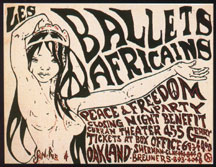 |
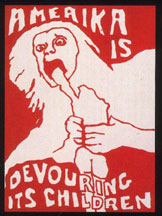 |
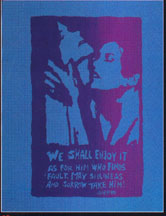 |
|---|
equent work quoted Goya [16(5)] and Sappho [33 (13)] and mimicked medieval manuscripts [39], testifying to a movement of young intellectuals with all history as their resource. By 1969, even their immediate political-art sources were wildly eclectic, as the distinctive designs of the Chinese and Cuban revolutions and the 1968 French student revolt became widely known. As influences multiplied, technical sophistication increased: John Heartfield's technique of political photomontage was promoted here in 1968 by Bruce Kaiper in a stunning photoserigraph, shot through a mezzotint filter [6(8)].
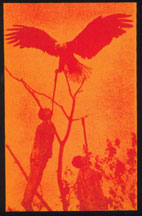
[The First Workshops Form in Campus Struggles]
Such work was a prelude to the fuller social development of the silkscreen poster movement, which began in earnest in 1968-69 in the crucible of campus struggles. By then, student activism had made every campus in the Bay Area not only a base for the anti-war movement, but an arena in itself. The conflicts over growing Third World student demands for minority studies programs, admissions, and hiring were most intense at San Francisco State College, where the longest, most violent student strike of the era began in fall 1968; and at the University of California's Berkeley campus, where the Third World Strike raged throughout the following spring.
Within these struggles, the first autonomous poster workshops condensed from the vitalized atmosphere, each involving an artist of singular talent and energy -- Malaquias Montoya at Berkeley
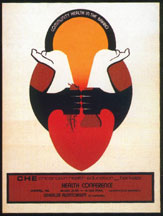 [38(23), 44, 45] and Rupert Garcia at S.F. State [10]. In the careers of these two Chicanos -- Montoya the activist, the prolific master of overnight creativity, who went on to teach hundreds and organize an endless chain of community workshops; Garcia the radicalized "artiste," the uncompromising craftsman of the image, who became the area's most renowned Third World artist -- a profound and complementary division is revealed, that inspired and fertilized the development of the social serigraphy movement.
[38(23), 44, 45] and Rupert Garcia at S.F. State [10]. In the careers of these two Chicanos -- Montoya the activist, the prolific master of overnight creativity, who went on to teach hundreds and organize an endless chain of community workshops; Garcia the radicalized "artiste," the uncompromising craftsman of the image, who became the area's most renowned Third World artist -- a profound and complementary division is revealed, that inspired and fertilized the development of the social serigraphy movement.
In these workshops, each worked with a small group that involved other young artists and even some faculty, but mostly untrained student volunteers, who helped with printing and attempted their own first designs. The SFS workshop produced perhaps fifty designs; the shorter UCB workshop, a dozen. Their strongest posters echoed the recent French student work, yet went beyond it, not being bound to illustrate slogans chosen by committees, with taut, brutal images that explained themselves -- the upraised fist surmounting the ivory tower 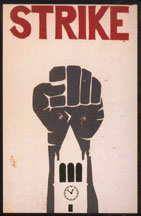 [8(3)], the club dripping blood spelling "education" [9].
[8(3)], the club dripping blood spelling "education" [9].
Though these first workshops were bent on vivid illumination of their generation's campus learning, their impulse was already bound into the community. Forced off-campus by official harrassment, the SFS workshop persisted for two years, turning also to civic concerns; its younger members went on to found the first Asian-American community workshop. The UCB workshop formed off-campus, in university space offered as a sop to student demands for a Chicano Art Center. Malaquias Montoya, its key organizer, was also active in the small, short-lived, seminal Mexican- American Liberation Art Front. With MALAF's Manuel Hernandez, he quickly went on to organize three small silkscreen workshops in Oakland community development centers, with support from Laney and Merrit Colleges. In fall 1969 another, nameless workshop formed in Berkeley. Its dozen young artists produced some twenty designs collectively by the following spring.
Rupert Garcia was active in Artes 6, another seminal group of Chicano artists including the postermaker Ralph Maradiaga, who helped MALAF's Rene' Yanez organize Galeria de la Raza in San Francisco in 1971, to showcase the sudden flowering of Chicano art. MALAF's Esteban Villa and Jose' Montoya also organized the small serigraphic workshop Royal Chicano Air Force in Sacramento in 1970; by 1986 it had produced over 150 designs [41]. The work of such postermakers during these years developed from their engagement with the early Farmworkers' movement, centered downstate in Delano. The poster workshop led there by Luis Valdez produced perhaps 200 designs from 1965-70, firmly establishing serigraphy as the chosen medium of Hispanic postermakers, and postermaking itself as a medium of cultural activism.
[The Spontaneous Workshops of May 1970]
This tentative rooting of workshops in the community was overshadowed by their next, prodigious development on campus. In May 1970, Nixon's bombing of Cambodia extended the war and ignited unprecedented demonstrations at home, as protesters were assassinated on three campuses. In this instant of national trauma, the seeds of political serigraphy already sown flowered in an explosion of spontaneous workshops at colleges and art schools around the Bay. The largest was at Berkeley, where the Art Gallery and Environmental Design buildings hosted an anarchy of production, open to anyone and supported by hundreds of volunteers, that went on for a month and printed some 250 designs, most on recycled computer paper  [16(5)][11-22]. In the Bay Area alone, the output of such transient workshops rivaled the legendary 500 designs of the French student revolt. Their national production was much greater, an unrivaled outpouring of graphic passion. This untutored, desperate plea for resistance and peace recorded the collective anguish vividly. Its stronger designs stand with the best serigraphy of political crisis.
[16(5)][11-22]. In the Bay Area alone, the output of such transient workshops rivaled the legendary 500 designs of the French student revolt. Their national production was much greater, an unrivaled outpouring of graphic passion. This untutored, desperate plea for resistance and peace recorded the collective anguish vividly. Its stronger designs stand with the best serigraphy of political crisis.
Though the political poster movement was already well begun, this prolific spasm accelerated it sharply, particularly in serigraphy. The workshops' output and outreach left activists vividly aware of the potentials of "poster power." Their images lingered for years in homes of the faithful, while a ferment of new images born from a dozen branches of progressive struggle flooded Movement offices and the streets.
[The Workshops Take Root in the Community]
 After this, the development of ongoing silkscreen workshops began in earnest, as young activists moved on from campus into the community. From the May 1970 workshop at the California College of Arts and Crafts, Bruce Kaiper and Gary Lapow organized the Media Project, a multi-media collective in Berkeley that produced some 300 designs over the next two years [23]. Malaquias Montoya was hired in fall 1970 at U.C. Berkeley to teach poster-making. His workshop-class continued until 1974, involving 200 students and producing over 800 designs [24]; most circulated in the community, for Montoya emphasized service for local groups. After instructing the May 1970 workshop at Laney College, GAW veteran Frank Rowe taught a poster-making class for two years. His students soon formed the East Bay Media workshop off-campus, and produced dozens of notable designs from 1971-73 [26(10), 27]. From 1971-72 another workshop, untraceable now, also flourished in Berkeley, producing designs remembered as outstanding [24].
After this, the development of ongoing silkscreen workshops began in earnest, as young activists moved on from campus into the community. From the May 1970 workshop at the California College of Arts and Crafts, Bruce Kaiper and Gary Lapow organized the Media Project, a multi-media collective in Berkeley that produced some 300 designs over the next two years [23]. Malaquias Montoya was hired in fall 1970 at U.C. Berkeley to teach poster-making. His workshop-class continued until 1974, involving 200 students and producing over 800 designs [24]; most circulated in the community, for Montoya emphasized service for local groups. After instructing the May 1970 workshop at Laney College, GAW veteran Frank Rowe taught a poster-making class for two years. His students soon formed the East Bay Media workshop off-campus, and produced dozens of notable designs from 1971-73 [26(10), 27]. From 1971-72 another workshop, untraceable now, also flourished in Berkeley, producing designs remembered as outstanding [24].
Meanwhile, Albert Borvice, an early student in Montoya's class, took on the project of organizing a true community-service workshop; and with Oscar Melara of La Raza en Accion Local founded the La Raza Silkscreen Center in San Francisco's Mission district in 1971. LRSC was the prototype Third World serigraphic workshop, serving a densely-concentrated, pan-Hispanic community with a multi-faceted activism -- and a strong graphic tradition, reborn through a generation of activist artists whose public murals were just then beginning to glorify the district. LRSC had a small, stable core of artists and printers (Melara, Linda Lucero, Pete Gallegos), and many occasional participants, including the notable independents Rupert Garcia and Juan Fuentes. Its designs were influenced by the Galeria de la Raza artists, and directly by Cuban and Mexican sources. Though LRSC's early designs were rudimentary [30], its artists soon brought forth splendid work [31 (11)].
community-service workshop; and with Oscar Melara of La Raza en Accion Local founded the La Raza Silkscreen Center in San Francisco's Mission district in 1971. LRSC was the prototype Third World serigraphic workshop, serving a densely-concentrated, pan-Hispanic community with a multi-faceted activism -- and a strong graphic tradition, reborn through a generation of activist artists whose public murals were just then beginning to glorify the district. LRSC had a small, stable core of artists and printers (Melara, Linda Lucero, Pete Gallegos), and many occasional participants, including the notable independents Rupert Garcia and Juan Fuentes. Its designs were influenced by the Galeria de la Raza artists, and directly by Cuban and Mexican sources. Though LRSC's early designs were rudimentary [30], its artists soon brought forth splendid work [31 (11)].
But LRSC was distinguished more for becoming the first workshop to support itself, through its work  and grant funding; and for its open service to the community. It produced posters for hundreds of groups and causes [47 (19), 51], ranging far beyond the Hispanic community, often involving their people in design and printing. Between this practice and ongoing classes, LRSC had taught silkscreen techniques to over 600 people by the time it reorganized in 1981. By then it had produced over 800 designs. Most bore the workshop's name and address, but few bore the name of an individual artist. An ethic of anonymity in social art, born in the anti-authoritarian heats of the 1960s, dominated the poster movement until the late 1970s, and through the mid-1980s many designs remained unsigned.
and grant funding; and for its open service to the community. It produced posters for hundreds of groups and causes [47 (19), 51], ranging far beyond the Hispanic community, often involving their people in design and printing. Between this practice and ongoing classes, LRSC had taught silkscreen techniques to over 600 people by the time it reorganized in 1981. By then it had produced over 800 designs. Most bore the workshop's name and address, but few bore the name of an individual artist. An ethic of anonymity in social art, born in the anti-authoritarian heats of the 1960s, dominated the poster movement until the late 1970s, and through the mid-1980s many designs remained unsigned.
The second major community workshop was organized in San Francisco's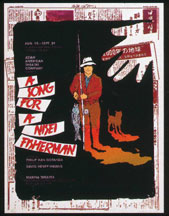 Chinatown in 1972 by Mike Chin and Jim Dong, who had learned serigraphy in the SFS workshop. The Kearny Street Workshop included writers and film-makers, and taught photography, ceramics, and sewing. But its core work was serigraphic. KSW developed a notable group of young Asian-American artists, including also Zand Gee, Stephanie Lowe of JAM, Leland Wong, Jack Loo, Nancy Hom [55], and Chester Yoshida [50 (22)]. Though KSW's work was focused in the Asian-American communities, various La Raza artists also taught, worked, and showed at KSW during the early years. This fluid and generous interplay among postermakers and workshops has been a central feature of the local serigraphic movement. In sharing technical expertise, production facilities, and visions of social art, Bay Area postermakers have constituted themselves as a true community of purpose, while supporting their individual development as committed artists.
Chinatown in 1972 by Mike Chin and Jim Dong, who had learned serigraphy in the SFS workshop. The Kearny Street Workshop included writers and film-makers, and taught photography, ceramics, and sewing. But its core work was serigraphic. KSW developed a notable group of young Asian-American artists, including also Zand Gee, Stephanie Lowe of JAM, Leland Wong, Jack Loo, Nancy Hom [55], and Chester Yoshida [50 (22)]. Though KSW's work was focused in the Asian-American communities, various La Raza artists also taught, worked, and showed at KSW during the early years. This fluid and generous interplay among postermakers and workshops has been a central feature of the local serigraphic movement. In sharing technical expertise, production facilities, and visions of social art, Bay Area postermakers have constituted themselves as a true community of purpose, while supporting their individual development as committed artists.
From the start, KSW's artists explored the newly-accessible techniques of photo-serigraphy. Inspired by the Cuban artist Mederos, they undertook the multi-color runs and richer hue-play that have since characterized the work of local Asian-American artists. Such Hispanic influences have scarcely affected their imagery, which draws deeply on Asian graphic traditions. Their better work is unrivaled in its delicacy and craft. KSW produced over 400 designs before being evicted in 1977 [37].
By then, the Japantown Art and Media center had opened in San Francisco's Japantown. Many of JAM's organizers had worked with KSW, and KSW artists continued to produce through JAM's facilities. Though KSW had not run as a business, its artists preferring their freedom to concentrate on the issues they chose, JAM's focus was as a community-service production shop. Over the next decade, JAM worked with hundreds of groups, and produced over 500 designs [46]. Besides teaching classes, as KSW had, JAM required a few people from each non-profit group it served to help with printing and often with design.
KSW and JAM together taught rudiments of social serigraphy to over 2,000 people in the Bay Area from 1972-86. Another 2,000 were taught by the various Hispanic workshops. The workshops' emphasis on participation, and the attitudes of sharing and mutual support that mark the social serigraphy movement, derive from the participatory, democratic, communal culture of the late 1960s, in which the movement's commitment was forged. Through this teaching, the community workshops have developed and liberated serigraphy as a social tool, placing it literally "in the hands of the people." The combined production of the workshops has been massive; but the anarchic production of their students, in every stream of activism, may well amount to more.
[Economic Realities]
In its fiscal heyday, JAM had up to five serigraphers on full-time (low) pay; and was able to help a connected group of East Bay artists begin a multi-media workshop in Oakland in 1979. The Community Asian Art & Media Project (CAAMP) flourished for two years, producing about forty-five designs [48] before its collapse after CETA (employment program) funding was cut off. JAM was able to shift to California Arts Council funding, but this dried up in turn. JAM has since depended on undependable help from local and national foundations, while developing itself as a "for-profit" production shop, at the cost of de-emphasizing non-profit services.
This summary reflects the experience of every community workshop. Social serigraphic service cannot support itself through work alone, even by producing decorative "art" prints as a sideline. Its flourishing here has been vitally dependent on support from philanthropic and governmental agencies. Parsimonious at best, this funding peaked in the late 1970s, dropped sharply during the Reagan era, and probably did not exceed one million dollars for all local postermaking combined from 1971 through 1986. Such a pittance has underwritten the development not only of a vital community service, but of a culture of committed art, its production a modest glory of our region and our time.
[The Workshops Keep Emerging]
During the early 1970s, the broad, many-stranded social Movement moved on from its early emphasis on protest to develop institutional alternatives, seeking ways to root progressive changes in the community. The community workshops themselves were a concrete expression of this move. Through them, in effect, the practice of political serigraphy was transformed into the broader practice of social serigraphy. Though protest posters remained prominent, the workshops' focus on community service bent social serigraphy into new areas, compelling the continual evolution of its iconography.  After LRSC's founding, Hispanic postermaking centers multiplied and diversified. An Oakland workshop begun in 1972 by Malaquias Montoya evolved into the community workshop Taller de Artes Graficas, a major multi-media center that produced some 400 designs by 1980, many by Montoya [38(23), 44, 45]. In San Francisco, the small workshop Taller Urayoan, begun in 1976 after its organizer studied at LRSC, focussed on solidarity work for Latin American liberation movements [36]. In the East Bay, Canton Posters, whose organizers had studied at TAG and LRSC, produced some forty designs from 1977-79, concentrating on drug education in the Chicano community. Such social needs led to the organizing of the Mission Cultural Center in San Francisco. MCC's graphic arm, supported by a small CETA stipend to its director Alfonso Maciel, served as a community workshop, producing some 400 designs from 1977-81 [49].
After LRSC's founding, Hispanic postermaking centers multiplied and diversified. An Oakland workshop begun in 1972 by Malaquias Montoya evolved into the community workshop Taller de Artes Graficas, a major multi-media center that produced some 400 designs by 1980, many by Montoya [38(23), 44, 45]. In San Francisco, the small workshop Taller Urayoan, begun in 1976 after its organizer studied at LRSC, focussed on solidarity work for Latin American liberation movements [36]. In the East Bay, Canton Posters, whose organizers had studied at TAG and LRSC, produced some forty designs from 1977-79, concentrating on drug education in the Chicano community. Such social needs led to the organizing of the Mission Cultural Center in San Francisco. MCC's graphic arm, supported by a small CETA stipend to its director Alfonso Maciel, served as a community workshop, producing some 400 designs from 1977-81 [49].
When funding ceased, MCC Graphics collapsed. By then, TAG, CAAMP, and Canton had folded for similar reasons. KSW and JAM had been displaced by urban "renewal" -- the former never to regather fully as a workshop, the latter to languish in a token room without production facilities, won reluctantly from Japantown cultural authorities unable to recognize the treasure at their feet. Besides such difficulties, growing concern for the health dangers in working with oil-based media led many printmakers to reduce their production runs (which had often reached 150-200 prints, and at times even 500), or to shift to other media. By 1981, such factors led LRSC itself to reorganize its external operation to emphasize offset lithography.
But by then, a second generation of activist postermakers, nurtured in the workshops of the first, was rising. After working at LRSC, Jos Sances revived MCC's workshop with Rene Castro in 1982, transforming it into Mission Grafica. After directing LRSC for four years, Herbert Siguenza [49] moved on to advise La Guacamaya [58], a small workshop of Salvadoran exiles begun in 1981 and concentrating on Central American solidarity work. JAM kept producing through other facilities, and developed its own second generation, including Richard Tokeshi and Wes Senzaki [57]. But the loss of its own print shop, LRSC's reorganization, and MCC Graphic's collapse left a strong demand for another community-service serigraphic production shop.
Mission Grafica filled this niche admirably, producing some 500 posters by 1986, for regional and distant groups. An automated press enabled MG to print three multi-color designs a week, while its artists developed technical mastery to rival the Asian-Americans', and complex, distinctive styles. Their finer work [59] integrates elements from many graphic streams, and reflects the rich diversity of the multi-ethnic community served by the social serigraphy movement. Indeed, the workshop is an epitome of the social serigraphy movement itself, which has been dedicated to the most local service, yet internationalist in perspective; intensely ethnic in focus, yet inter-racial in cooperation. These qualities are embodied in Mission Grafica -- run by Sances, of Sicilian descent, and Castro, a Chilean refugee, serving a pan-Hispanic community, and now printing the work of Asian-American artists.
[White Postermakers]
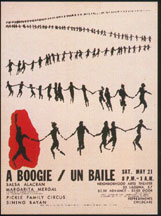
White postermakers have been involved in this movement from the first, notably in the May 1970 campus workshops. Following this, the Media Project, East Bay Media, and an unidentified workshop flourished in the East Bay for two years. In 1972, six artists drawn together in an early food-buying cooperative formed the Noe Valley Silkscreen Collective, with help from LRSC's Oscar Melara, and produced twelve designs in the next two years [25]. Ron Weil of NVSC went on to help found Gonna Rise Again Graphics, also in San Francisco, in 1975; its six artists produced about thirty posters before dispersing in 1977 [40 (17)]. Both groups were comprised mainly of women, who played major roles also in KSW, JAM, and LRSC. Though the local feminist movement has been richly supplied with silkscreens, from these and other sources, it's notable that prominent feminist serigraphic workshops have developed in Chicago and New York, but not here.

In 1976, Barbara Morgan began Red Pepper Posters in San Francisco, after working with the Chicago Women's Graphics Collective. Founded in 1970, CWGC's bold serigraphs dominated the national feminist poster market for a decade. Morgan followed CWGC's custom, unusual here, of endlessly reprinting its portfolio, and produced twenty-one designs over the next decade. [39]. In Richmond, Doug Minkler began designing political serigraphs in 1979, with jagged, energetic imagery based often in paper collage [56(20)]. By 1986, he had produced some sixty designs; and he and Jos Sances had become the Bay Area's most prominent white political serigraphers.
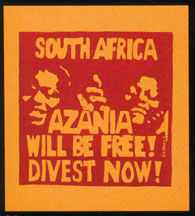
Such individuals were joined in 1981 by Fireworks, a multi-media collective in San Francisco that produced about forty-five silkscreened designs in its first five years. Fireworks evolved as an independent political project, from its members' engagement with a radical splinter group. Held together by ideological bonds and perspectives of purpose, the group has provided an alternate model to the community workshop and the individual artist, for how political serigraphy can be sustained. Though burdened at times with ideological intents, Fireworks' best work has deserved its wide posting [60(24)].
In such ways, Fireworks extended the tradition of the San Francisco Poster Brigade, begun (as the Wilfred Owen Brigade) by Rachel Romero and Leon Klayman in 1974. By 1983 they had produced over 400 posters for community and international causes, printing many of their bold designs from linoleum-blocks before reprinting them in offset editions. As the pre-eminent none-ethnic poster workshop, SFPB's emphasis on hand-printed craft complemented the Third World workshops' serigraphic focus. The group exhibitions SFPB organized, from 1977 on, worked to unify the entire Bay Area postermaking community.
[Some Ethnic Considerations]
Compared to the Third World workshops, NVSC, GRAG, and Fireworks developed their themes and designs in more intensely collective processes that worked to limit their production. No deep ideological affinities bound NVSC's and GRAG's members together, beyond the desire to make art serve various good causes, and they shared no ethnic commitment or graphic heritage; so the motions of their young lives soon pulled the groups apart. Yet their early work was as promising as LRSC's and KSW's, and their situation had a similar potential. For white progressives too had immediate communities to relate to, concentrated in neighborhoods and alive with as many groups and causes, needing as many posters, as the Third World communities. That no major community-service workshop developed around a white core-group may have been due in part to early development of the Third World workshops, which somewhat preempted the territory; and also to differences of attitude, about how to put art in service.
But the deeper difference was one of culture, involving the artist's relationship with his or her own work. For the Hispanic and Asian-American postermakers did not passively inherit the rich graphic traditions of their own cultures, which already afforded them an active relationship with graphic expression. Caught up in their generation's struggle for ethnic affirmation, they explored and re-appropriated these heritages in the process of reclaiming and re-creating their own identities as Chicanos, Japanese-Americans, etc. In this, they experienced a manner of making art serve vital use, quite different from the traditional (white) Left's use of art as propaganda. At work in communities in which the poster itself served as a unifying, grounding cultural force, an artifact of self-determination, for them the very act of designing posters was in itself a coherent and intimate mode of political-cultural expression, at once personal and collective, in a way that had no parallel in white postermakers' experience. This may help account for the remarkable vitality not only of the Third World postermakers individually, but of the workshops they have organized.
(The prominent example of Emory Douglas, the Black Panther Party's main (offset) poster designer during the late 1960s in Oakland, helped to inspire other Third World postermakers. But Black postermakers in the Bay Area have made relatively little use of serigraphy, and rarely participated in workshops, nor formed them till at last one came to flourish at Laney College in Oakland.)
[The State of the Art in 1986]
The broad ferment from which new postermakers emerge continues to develop here. In Oakland, Malaquias Montoya has taught a workshop at California College of Arts and Crafts since 1980. His 200 students have produced over 600 designs; and have gone on to help form the Oakland workshop Taller Sin Fronteras, responsible for some 50 designs since 1984, and Kevin Williams' Hit Squad, producing independently since 1985. In San Francisco, a workshop in the South of Market Area Cultural Center, led by Bill Roarty, produced many designs from 1980-84 [55], and is developing a major screenprinting facility to serve artists and groups throughout the city. At least six workshops and many individual artists are currently producing social serigraphs in the Bay Area. People have tended since the early 1970s to speak of this work's golden age as past; yet its scope and volume, its technical and artistic qualities, and its productive community are still developing. This extraordinary chapter of social art's history will grow fuller and richer before it closes.
[A Brief Note on Iconography]
Alhough the poster movement began while the mid-1960s social movement was opening radically to new cultural influences, much of its early work adapted traditional motifs from the iconography of the Old Left
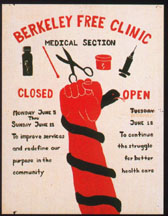 |
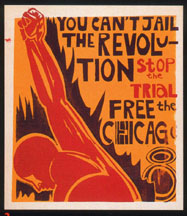 |
 |
|---|
-- the defiant fist [3(4), 7 (2), 8 (3)], the bloody club [9, 12, 23], the dove of peace [17, 18]. This was partly because so much of the time's activity was connected with violent conflict; but more deeply, because the Old Left's iconography was as much of a common graphic heritage as the new movement had. When the New Left's postermakers looked beyond this limited heritage, their search was rootless, and at first often drew on the developing iconography of the "counterculture"[5(6), 6].
beyond this limited heritage, their search was rootless, and at first often drew on the developing iconography of the "counterculture"[5(6), 6].
 |
 |
 |
 |
|---|
As the workshops took root in the community during the 1970s, the poster movement's iconography grew richer, for several reasons. The ethnic movements evolved from civil rights protest to cultural affirmation and community development. This involved their poster-makers first in revitalizing their own graphic heritages [31(11), 44, 48-50(22), 52],and then in assimilating each other's symbols and styles [55, 58]. New symbols and iconography developed to express the concerns of new movements -- the feminist [39], gay and lesbian [32, 33(13), 43, 51], environmental [56(20)], community health [45], holistic health [38(23)] , drug-legalization[28(12)], anti-psychiatric-confinement [35(14)], and anti-nuclear-war [53, 61] movements, among others -- all developing beyond the traditional boundaries of political concern and graphic discourse.
 |
 |
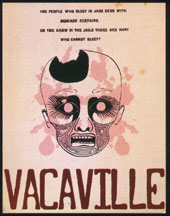 |
|---|
Beyond enriching the iconographic vocabulary of local poster design, these developments have contributed to a culture of postermaking that challenges its artists to develop their own ways of using this vocabulary to good effect.
Michael Rossman
Berkeley, November 1986
==================================================
[Acknowledgements]
I am indebted to Dennis Beall, Scott Bradey, Gil Chavez, Robin Cherin, Dick Correll, Lincoln Cushing, Jim Dong, Joe Fisher, Irving Frohmer, Pete Gallegos, Rupert Garcia, Nancy Hom, Bruce Kaiper, Lisa Kokin, Linda Lucero, Oscar Melara, Doug Minkler, Jose Montoya, Malaquias Montoya, Barbara Morgan, Jane Norling, Sally Robertson, Margaret Rowe, Jos Sances, Dugald Stermer, Leon Sun, Dennis Taniguchi, and Luis Valdez for the conversations on which my interpretations are based; and to the de Saisset Museum's former director Georgianna Lagoria, for inviting the exhibit and this catalogue essay.
Return to: | Index to Poster Writing